Just as city dwellers seek to reconnect with nature, you’ll find that incorporating plants into your living room can transform it into a refreshing sanctuary. Whether you’re working with a compact apartment or spacious home, these nine styling approaches offer practical solutions for bringing the outdoors inside. From creating dramatic plant walls to designing intimate reading nooks with cascading greenery, you’ll discover how strategic placement and thoughtful selection can maximize both aesthetics and function in your space.
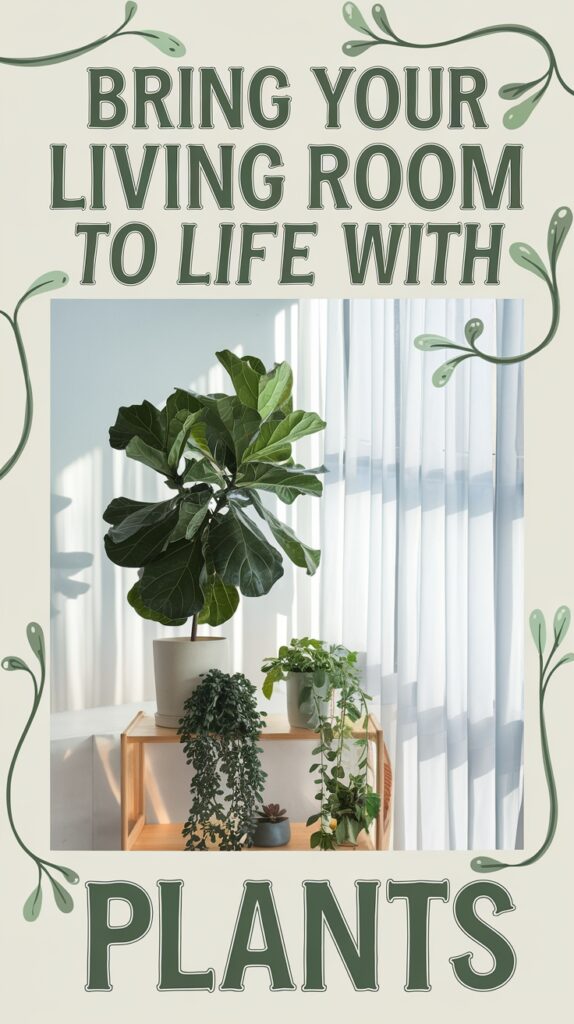
Contents
- 1 Create a Striking Plant Wall Display
- 2 Design a Cozy Reading Nook With Hanging Plants
- 3 Style Your Coffee Table With Miniature Gardens
- 4 Layer Plants at Different Heights for Visual Interest
- 5 Mix Plant Textures and Leaf Patterns
- 6 Transform Empty Corners With Statement Plants
- 7 Arrange a Window Garden Sanctuary
- 8 Blend Plants With Built-In Shelving
- 9 Showcase Trailing Plants on Room Dividers
Create a Striking Plant Wall Display

A plant wall display transforms an ordinary living room wall into a stunning vertical garden, creating a dramatic focal point that brings life and dimension to your space. By arranging various plants at different heights using wall-mounted planters, floating shelves, or specialized living wall systems, you can design a lush, layered look that maximizes vertical space while minimizing floor footprint.
The display can incorporate a mix of trailing plants, upright foliage, and flowering specimens to achieve depth and visual interest.
Growing Conditions:
- Bright, indirect light for most indoor plants; avoid direct sunlight which can burn leaves
- Adequate air circulation to prevent moisture-related issues
- Well-draining potting mix suitable for each plant variety
- Consistent room temperature between 65-80°F (18-27°C)
- Moderate humidity levels (40-60%)
- Regular watering schedule based on individual plant needs
Regular maintenance is crucial for a thriving plant wall display. Inspect plants weekly for signs of pests or disease, and rotate plants periodically to ensure even growth.
Prune dead or yellowing leaves promptly, and dust foliage monthly to maintain photosynthesis efficiency. Install a proper watering system or develop a consistent watering routine that accounts for different plant needs and varying heights.
Consider incorporating a mix of low-maintenance plants to create a sustainable display that doesn’t require constant attention.
Design a Cozy Reading Nook With Hanging Plants
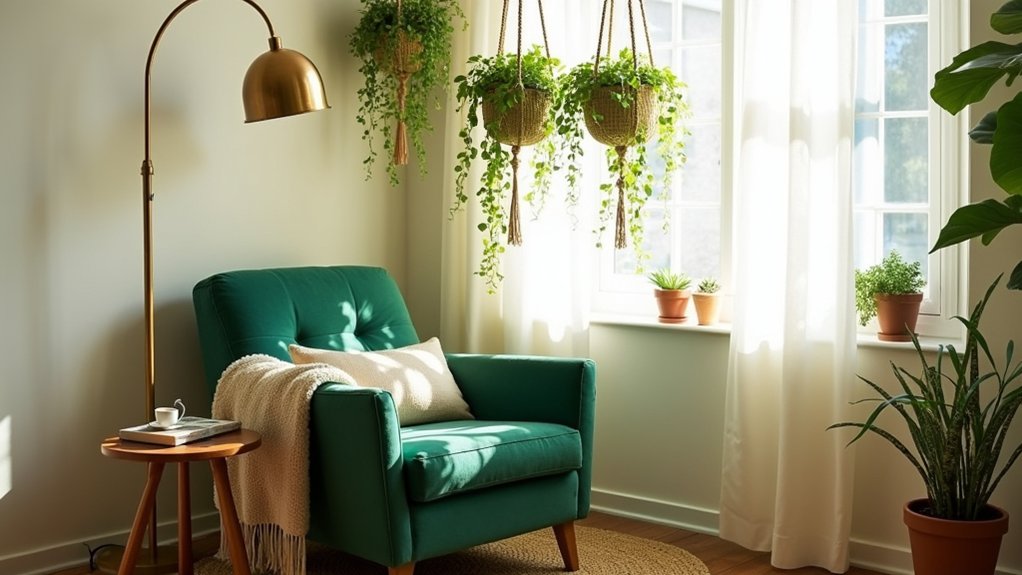
Transform a corner of your living room into an inviting reading sanctuary by creating a cozy nook adorned with cascading hanging plants.
Position a comfortable armchair or window seat beneath strategically placed hanging planters filled with trailing specimens like pothos, spider plants, or string of pearls.
Layer the space with soft cushions and throws while allowing the flowing greenery to create a natural canopy overhead, establishing a tranquil atmosphere perfect for diving into your favorite books.
Growing Conditions:
- Bright, indirect light is ideal for most hanging plants, though some varieties can tolerate lower light.
- Water when the top inch of soil feels dry, typically every 7-10 days.
- Use well-draining potting mix specifically formulated for indoor plants.
- Maintain room temperatures between 65-75°F (18-24°C).
- Provide moderate humidity through misting or a nearby humidity tray.
- Choose lightweight containers with proper drainage holes.
Regular maintenance ensures your reading nook’s hanging garden remains lush and healthy throughout the year.
Rotate plants quarterly to ensure even growth, trim yellowing or dead foliage promptly, and dust leaves monthly with a damp cloth to maintain their ability to photosynthesize effectively.
Check hanging hardware monthly for security, and repot plants every 2-3 years or when they become root-bound to prevent stagnant growth and maintain their vibrant appearance.
Style Your Coffee Table With Miniature Gardens
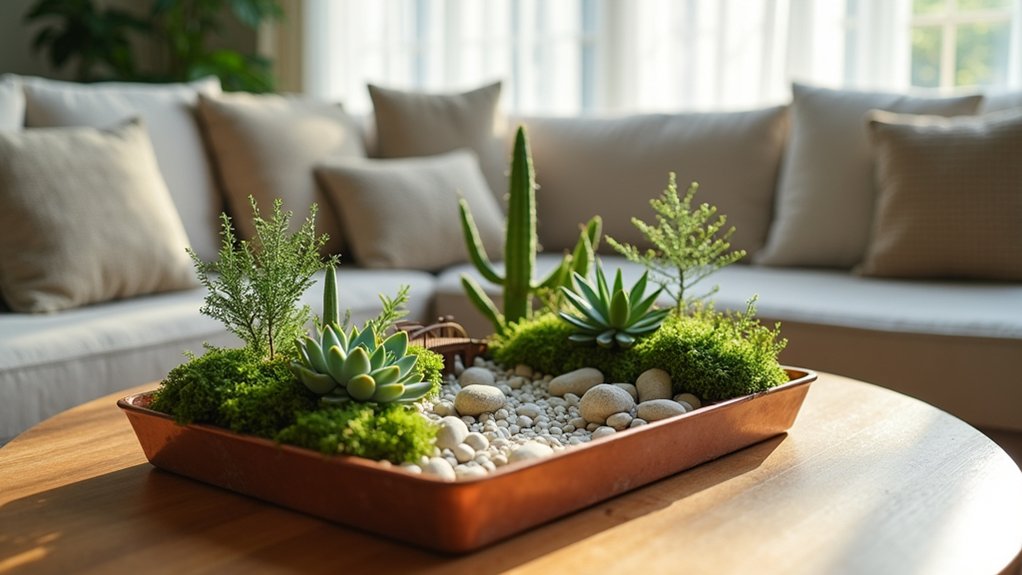
Creating a miniature garden on your coffee table brings a slice of nature into your living space while serving as an eye-catching centerpiece. These small-scale landscapes typically feature tiny succulents, moss, and diminutive plants arranged in shallow decorative containers with miniature accessories like pebbles, small figurines, or architectural elements.
The combination creates a living artwork that adds depth and personality to your coffee table while maintaining a compact footprint suitable for indoor viewing.
Growing Conditions:
- Bright, indirect light – avoid direct afternoon sun
- Well-draining potting mix specifically for succulents and miniature plants
- Container must have drainage holes to prevent root rot
- Room temperature between 65-75°F (18-24°C)
- Moderate humidity levels around 40-50%
- Protection from air vents and drafts
Regular grooming and thoughtful care will keep your coffee table garden looking pristine. Trim any yellowing leaves or overgrown sections to maintain the desired shape and scale.
Rotate the container quarterly to ensure even growth, and dust the leaves gently with a small brush to keep them clean and photosynthesizing effectively. When selecting new plants for the arrangement, choose specimens with similar care requirements to ensure all elements of your miniature garden thrive together.
Layer Plants at Different Heights for Visual Interest
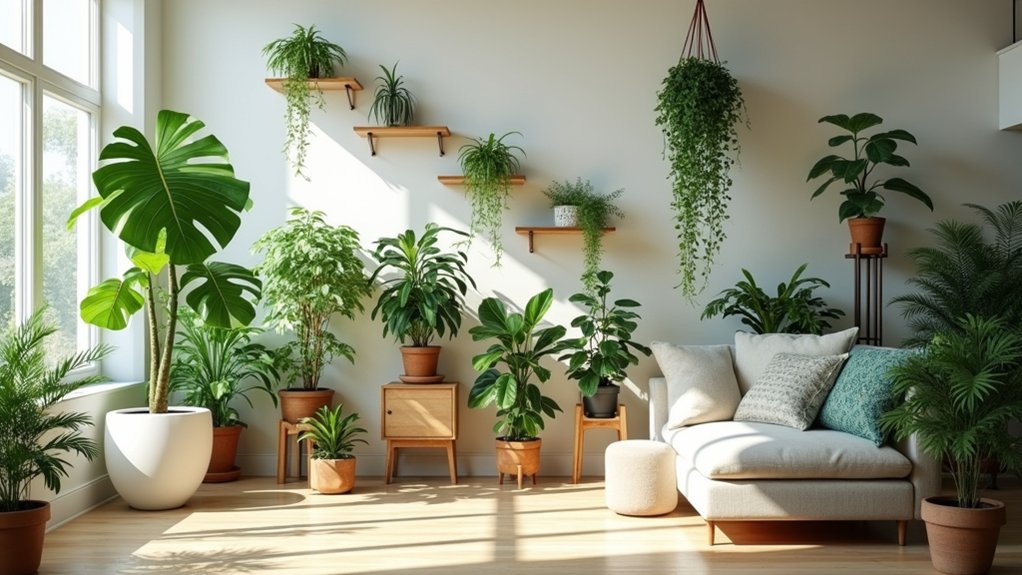
Creating depth and dimension in your living room through layered plant heights transforms a flat space into a dynamic indoor garden. By positioning plants at various elevations – from floor-standing specimens to elevated shelving displays and hanging varieties – you establish a natural, forest-like atmosphere that draws the eye upward and outward.
This multi-level approach can be achieved using plant stands, wall-mounted shelves, hanging baskets, and naturally varying plant heights from tall floor plants like fiddle leaf figs to cascading pothos on high surfaces.
Growing conditions for a successful layered plant display:
- Light exposure should vary by height – higher plants need brighter light while lower plants can tolerate shade
- Air circulation needs increase with height – ensure adequate airflow around elevated plants
- Water requirements differ by position – hanging plants dry faster than floor-level ones
- Support structures must be sturdy and well-anchored for elevated plants
- Temperature gradients exist (warmer air rises) – consider heat tolerance for higher positioned plants
Maintaining a layered plant display requires regular evaluation of each plant’s position and growth patterns.
Rotate plants quarterly to ensure even growth and prevent reaching toward light sources. Prune strategically to maintain desired shapes and sizes while preventing overcrowding between layers.
Check support structures monthly for stability, especially for hanging plants and wall-mounted displays. Dust leaves at all levels regularly, using a stepladder when necessary to reach higher specimens, maintaining both plant health and visual appeal.
Mix Plant Textures and Leaf Patterns
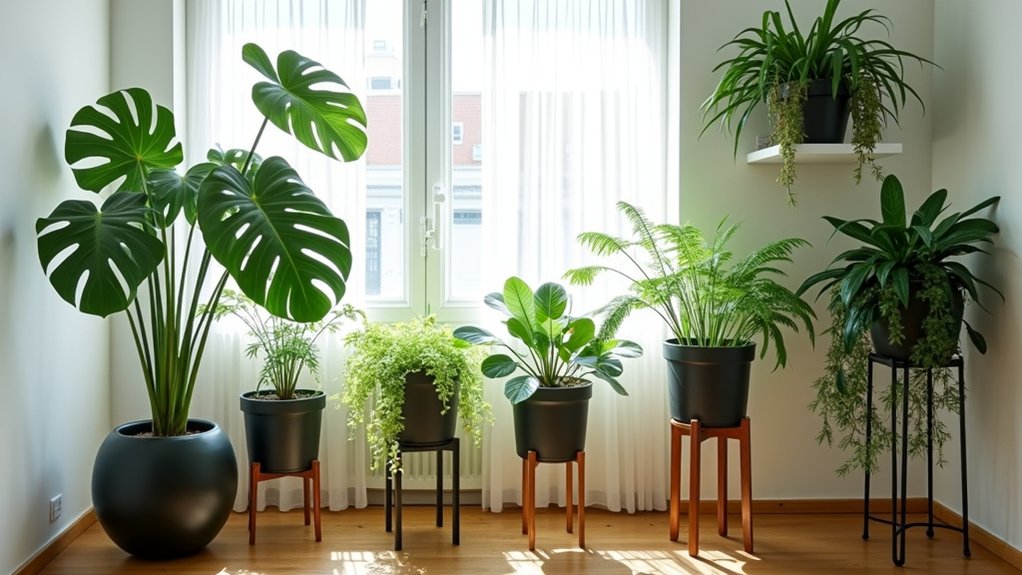
Creating visual interest in your living room through varied plant textures and leaf patterns adds depth and dimension to your space. Combining plants with large, glossy leaves like rubber plants alongside delicate, lacy ferns creates dynamic contrast, while mixing spiky snake plants with trailing pothos adds vertical and horizontal elements.
Incorporating different leaf shapes, sizes, and variegation patterns develops a layered, botanical look that maintains visual harmony while celebrating natural diversity.
Light Requirements:
- Position each plant according to its individual light needs
- Group shade-loving plants away from direct sunlight
- Place sun-loving varieties near windows
- Rotate plants regularly to ensure even light exposure
- Use sheer curtains to filter harsh direct light
Water Needs:
- Check moisture levels for each plant individually
- Group plants with similar watering needs together
- Water thoroughly when soil is dry to touch
- Ensure proper drainage for all containers
- Adjust watering frequency seasonally
Soil Preferences:
- Use well-draining potting mix
- Add perlite or sand for succulents and cacti
- Include organic matter for moisture-loving plants
- Choose soil appropriate for each plant type
- Refresh soil annually
To maintain a healthy and visually appealing plant collection, regularly dust leaves with a damp cloth to keep them clean and photosynthesizing efficiently.
Prune dead or yellowing foliage promptly to maintain aesthetics and prevent disease spread. Monitor for signs of pests or illness by inspecting leaves weekly, particularly where different plant varieties touch.
Fertilize during growing seasons with appropriate nutrients for each plant type, and occasionally rearrange plants to create fresh visual combinations while ensuring optimal growing conditions are maintained.
Transform Empty Corners With Statement Plants
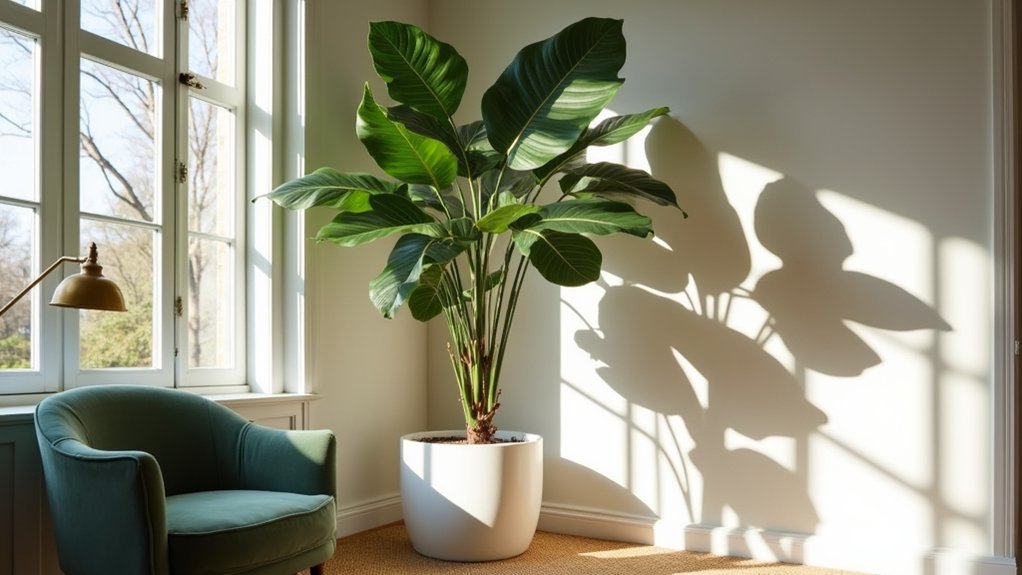
Empty corners in living spaces can be dramatically transformed using large, architectural plants that serve as natural focal points. Statement plants like Fiddle Leaf Figs, Bird of Paradise, or Monstera Deliciosa create striking vertical interest while softening angular corners with their organic shapes and lush foliage.
These dramatic specimens not only fill unused space but also add depth, texture, and a sense of luxury to room corners that might otherwise feel stark or neglected.
- Light Requirements: Bright, indirect sunlight; avoid direct afternoon sun
- Water Needs: Moderate watering when top 1-2 inches of soil feels dry
- Soil Type: Well-draining, nutrient-rich potting mix
- Humidity: 40-60% relative humidity
- Temperature: 65-80°F (18-27°C)
- Container: Large pot with drainage holes, sized appropriately for plant
- Support: Stakes or moss poles for climbing varieties
Regular grooming is essential for maintaining statement corner plants in peak condition. Remove any yellowing or dead leaves promptly, rotate the plant quarterly to ensure even growth, and dust leaves monthly with a damp cloth to maintain their glossy appearance and maximize light absorption.
Inspect regularly for pests, particularly on the undersides of leaves, and maintain adequate spacing between the plant and walls to ensure proper air circulation and prevent moisture-related issues.
Arrange a Window Garden Sanctuary
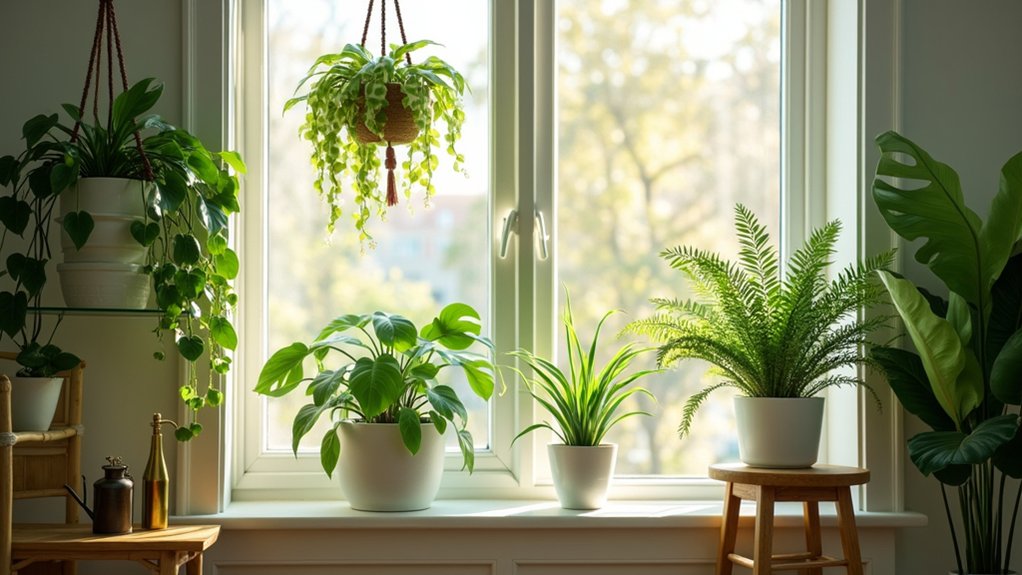
A window garden sanctuary transforms an ordinary living room window into a lush, vertical display of cascading greenery and vibrant foliage. This arrangement features a carefully curated collection of plants positioned on window sills, hanging planters, and tiered shelving units that maximize natural light exposure.
Plants of varying heights, textures, and shades of green create a dynamic visual display while establishing a peaceful transition between indoor and outdoor spaces.
- Light: Bright, indirect sunlight; morning sun preferred; protect delicate plants from harsh afternoon rays
- Water: Varying needs based on plant selection; generally water when top 1-2 inches of soil feels dry
- Humidity: 40-60% relative humidity; use pebble trays or humidifiers if needed
- Temperature: 65-80°F (18-27°C), avoid cold drafts from windows
- Soil: Well-draining potting mix appropriate for each plant type
- Spacing: Allow 6-12 inches between plants for proper air circulation
Regular grooming and rotation ensure a thriving window garden sanctuary. Rotate plants quarter-turns weekly to promote even growth and prevent leaning toward light sources.
Dust leaves monthly with a damp cloth to maintain photosynthesis efficiency and aesthetic appeal. Inspect plants weekly for signs of pests or disease, particularly where foliage overlaps.
Trim yellowing leaves and spent blooms promptly to maintain the sanctuary’s pristine appearance and redirect energy to healthy growth.
Blend Plants With Built-In Shelving
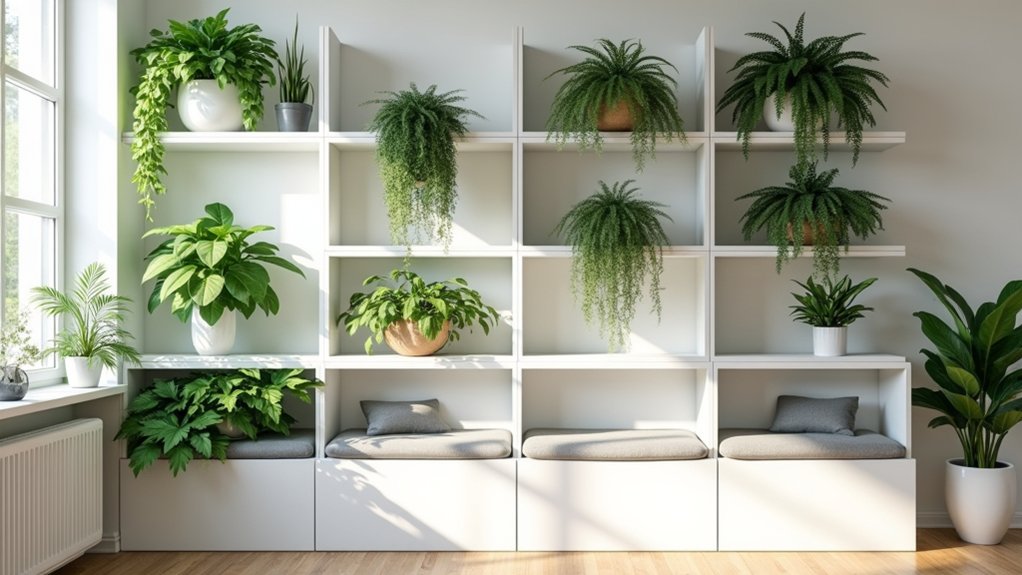
Built-in shelving offers an elegant way to incorporate greenery into your living room’s architecture while maximizing vertical space.
Plants placed strategically on shelves create a natural gallery effect, with cascading varieties draping over edges and upright specimens adding height variation. The combination of wooden or painted shelving with lush foliage creates an organic-meets-structured aesthetic that can serve as a living focal point while maintaining a clean, organized appearance.
- Light: Most shelf-suitable plants need bright, indirect light; east or north-facing windows are ideal
- Water: Varies by plant species; ensure shelves have proper drainage or use cachepots
- Humidity: 40-60% for most indoor plants; group plants together to increase humidity
- Temperature: Maintain 65-80°F (18-27°C), away from heating/cooling vents
- Space: Allow 6-12 inches between plants for proper air circulation
- Weight consideration: Check shelf weight capacity before placing heavy planters
Regular dusting of both leaves and shelves prevents pest issues and maintains the display’s aesthetic appeal.
Rotate plants quarterly to ensure even growth, and periodically assess the arrangement, moving plants as they grow or replacing those that become too large for the space.
Install grow lights if natural light is insufficient, and consider installing a drip tray system or moisture-resistant shelf coating to protect the shelving material from water damage.
Showcase Trailing Plants on Room Dividers
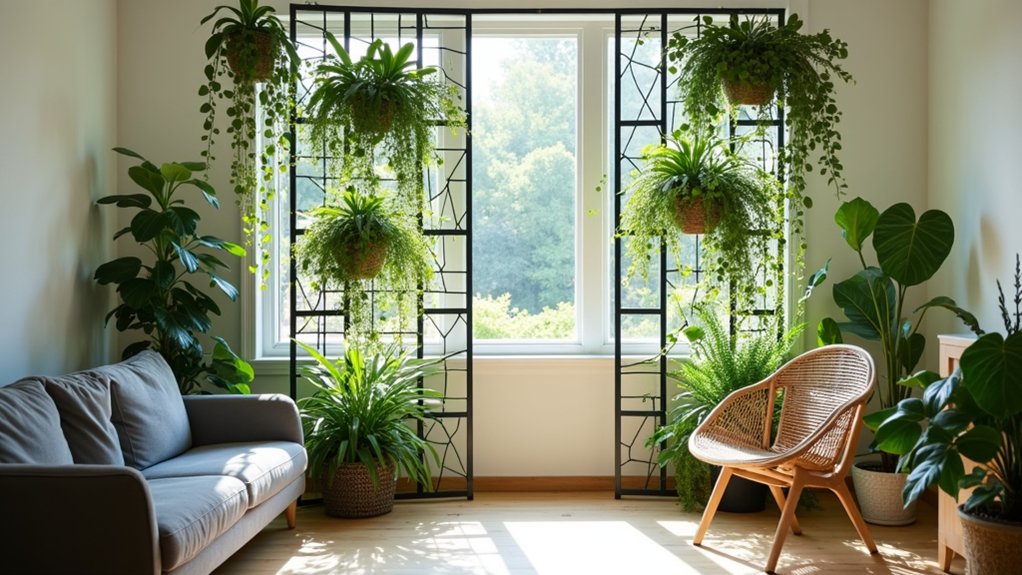
Trailing plants on room dividers create a stunning natural screen effect that adds both privacy and visual interest to living spaces.
Plants like Pothos, String of Pearls, or English Ivy cascade elegantly down decorative screens or open shelving units, softening hard edges while creating distinct zones within a room.
These living curtains of greenery bring movement and organic flow to the space, effectively blending form and function in interior design.
- Light: Bright, indirect light; avoid direct sunlight which can scorch leaves
- Water: Allow top inch of soil to dry between waterings
- Soil: Well-draining potting mix with added perlite
- Humidity: Moderate to high (40-60%)
- Temperature: 65-80°F (18-27°C)
- Container: Planters with drainage holes, mounted securely to divider
- Fertilizer: Balanced liquid fertilizer monthly during growing season
Regular maintenance of trailing plants on room dividers requires strategic pruning to maintain desired length and fullness.
Trim leggy stems to encourage bushier growth, and remove any yellowed or damaged leaves promptly.
Rotate containers periodically to ensure even growth, and dust leaves monthly with a damp cloth to maintain their ability to photosynthesize effectively.
Train new growth along support structures as needed, and check mounting hardware regularly to ensure plants remain securely attached to the divider.
